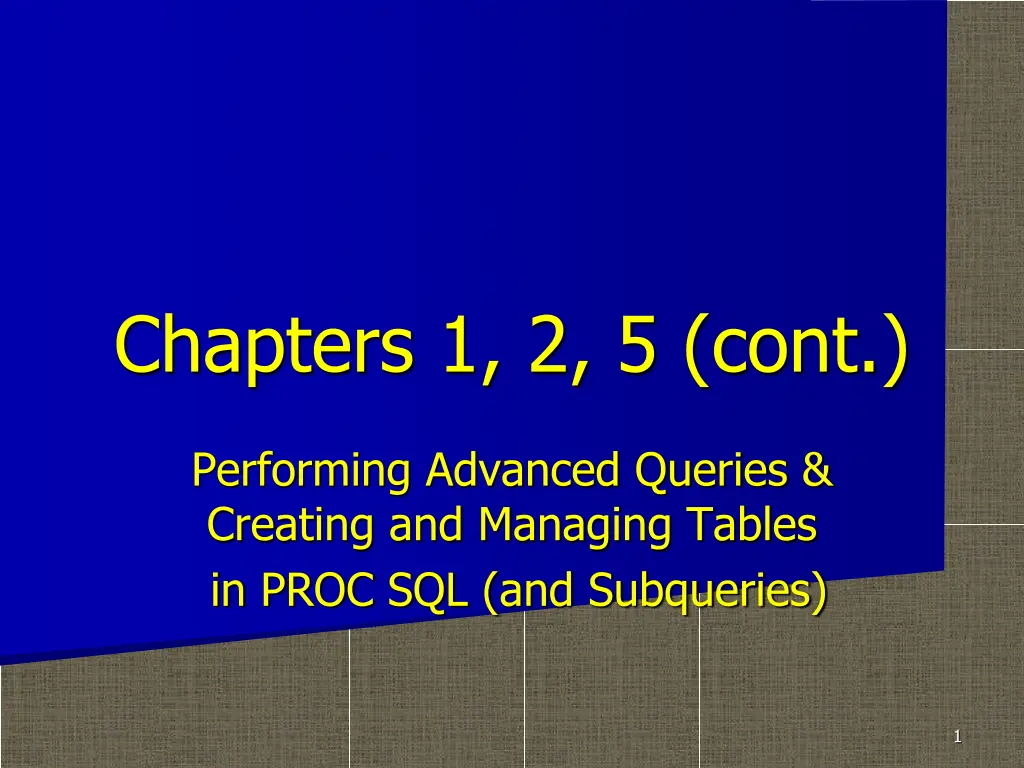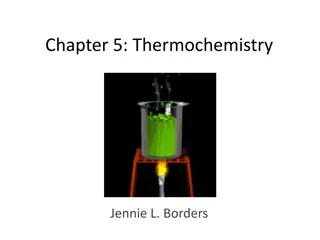
Advanced PROC SQL Techniques for Data Analysis
Master the art of advanced queries and table management in PROC SQL to efficiently analyze datasets, select all columns, limit row outputs, and eliminate duplicates for enhanced data manipulation and reporting.
Download Presentation

Please find below an Image/Link to download the presentation.
The content on the website is provided AS IS for your information and personal use only. It may not be sold, licensed, or shared on other websites without obtaining consent from the author. If you encounter any issues during the download, it is possible that the publisher has removed the file from their server.
You are allowed to download the files provided on this website for personal or commercial use, subject to the condition that they are used lawfully. All files are the property of their respective owners.
The content on the website is provided AS IS for your information and personal use only. It may not be sold, licensed, or shared on other websites without obtaining consent from the author.
E N D
Presentation Transcript
Chapters 1, 2, 5 (cont.) Performing Advanced Queries & Creating and Managing Tables in PROC SQL (and Subqueries) 1
Displaying All Columns To select all columns included in a table use one of two options List all variables from the table in the select clause The order of the columns will be based on the order the columns appear in the select clause Use select * in the select clause The order of the columns will be based on the order in which they are stored in the table 2
Example Displaying all Fields Proc sql; select player, atbats, hits, bb from bbstats; Proc sql; select * from bbstats; * Both sets of code return the same result from the bbstats dataset. 3
Example Displaying all Fields Resulting Dataset Player Christian Walker Scott Wingo Brady Thomas Evan Marzilli Robert Beary Adrian Morales Peter Mooney Jake Williams Jackie Bradley Jr. At Bats 271 240 231 220 211 249 254 209 162 Hits 97 81 73 64 61 70 71 56 40 BB 36 44 23 25 12 30 44 21 22 4
FEEDBACK OPTION Use when select * is included in the select clause to see the list of columns The list of columns will be written to the SAS log 5
OUTOBS= Option Use to limit the number of rows displayed Similar to the obs= data set option OUTOBS does not limit the number of rows that are read. To restrict the number of rows read use the INOBS= option 6
Example OUTOBS=Option Proc sql outobs=5; select player, atbats from bbstats; quit; player Christian Walker Scott Wingo Brady Thomas Evan Marzilli Robert Beary atbats 271 240 231 220 211 7
Removing Rows That Contain Duplicate Values Use the keyword DISTINCT in the select statement to eliminate rows with the same values 8
Example Eliminating Rows that Contain Duplicate Values Player Christian Walker Scott Wingo Brady Thomas Evan Marzilli Robert Beary Adrian Morales Peter Mooney Jake Williams Jackie Bradley Jr. Scott Wingo At Bats 271 240 231 220 211 249 254 209 162 240 Hits 97 81 73 64 61 70 71 56 40 81 BB 36 44 23 25 12 30 44 21 22 44 * In the table above, Scott Wingo appears twice. 9
Example Eliminating Rows that Contain Duplicate Values proc sql; select distinct player, atbats, hits, bb from bbstats; quit; 10
Example Eliminating Rows that Contain Duplicate Values Player Christian Walker Scott Wingo Brady Thomas Evan Marzilli Robert Beary Adrian Morales Peter Mooney Jake Williams Jackie Bradley Jr. At Bats 271 240 231 220 211 249 254 209 162 Hits 97 81 73 64 61 70 71 56 40 BB 36 44 23 25 12 30 44 21 22 11
Conditional Operators Between-and Contains or ? In Is missing or is null Like Any All Exists 12
Between-and Operator Used to extract rows based on a range of numeric or character values Used in the where clause 13
Example Between-and Operator player Robert Beary Jake Williams Jackie Bradley Jr. atbats 211 209 162 Proc sql; select player, atbats from bbstats where atbats between 162 and 215; quit; 14
Example not Between-and Operator player Christian Walker Scott Wingo Brady Thomas Evan Marzilli Adrian Morales Peter Mooney atbats 271 240 231 220 249 254 Proc sql; select player, atbats from bbstats where atbats not between 162 and 215; quit; 15
Contains or Question Mark (?) Operator to Select a String Usually used to select rows based on a particular string in a character column. Matching is case sensitive when making comparisons Use the UPCASE function if comparison is based on all capital letters and there is a mix of upper and lower case letters 16
Example Contains or Questions Mark (?) Operator Proc sql; select player, atbats from bbstats where upcase(name) contains IA ; quit; player Christian Walker Adrian Morales Jake Williams atbats 271 249 209 17
IN Operator to Select Values from a List Use to select rows that match values in a list List can include numeric or character values 18
Example IN Operator Proc sql; select player, atbats from bbstats where name in ( Christian Walker , Jake Williams ); quit; player Christian Walker Jake Williams atbats 271 209 19
Is Missing or Is NULL Operator Use to select rows that contain missing values, character and numeric The IS MISSING and IS NULL operators are interchangeable 20
Like Operator Use to select rows that contain a specific pattern of characters Special characters Use underscore (_) to represent a single character Use the percent sign (%) to represent any sequence of characters 21
Example Like Operator Player Jake Williams Jackie Bradley Jr. atbats 209 162 Proc sql; select player, atbats from bbstats where player like Ja% ; quit; 22
Sounds-Like (=*) Operator Use to select rows that contain a value that sounds like another value. 23
Subsetting Rows by Calculated Values Use the keyword CALCULATED in the where clause to subset the data based on a value that is calculated within the query 24
Example Using a Calculated Value in the Where Clause Proc sql; select player, hits/atbats as avg from bbstats where calculated avg > .300; quit; player Christian Walker Scott Wingo Brady Thomas avg .358 .338 .316 25
Column Labels, Column Formats Titles and Footnotes Use the label= option to specify the label to display for the column Use the format= option to specify the format to display data in the column Title and footnote statements must be placed in one of the following locations Before the PROC SQL statement Between the PROC SQL statement and the select statement 26
Example Label, Format, and Title Proc sql; title Averages for 2011 USC Gamecocks ; select player label= Player Name , hits/atbats as avg label= Average format=4.3 from bbstats; quit; Averages for 2011 USC Gamecocks Player Name Christian Walker Scott Wingo Brady Thomas Evan Marzilli Robert Beary Adrian Morales Peter Mooney Jake Williams Jackie Bradley Jr. Average .358 .338 .316 .291 .289 .281 .280 .268 .247 27
Adding a Character Constant to Output To define a new column that contains a character string, include a text string in quotation marks in the SELECT clause. 28
Example Adding a Character Constant to Output Proc sql; select player, average is: , hits/atbats as avg from bbstats; quit; Peter Mooney Jake Williams Jackie Bradley Jr. player Christian Walker Scott Wingo Brady Thomas Evan Marzilli Robert Beary Adrian Morales avg average is: .358 average is: .338 average is: .316 average is: .291 average is: .289 average is: .281 average is: .280 average is: .268 average is: .247 29
Summarizing and Grouping Data A summary function can be used in PROC SQL to produce a statistical summary of data in a table. Examples of summary functions avg average of values count number of nonmissing values min smallest value std standard deviation sum sum of values 30
Summarizing and Grouping Data If a GROUP BY clause is not present in the query, PROC SQL will apply the function to the entire table. If a GROUP BY clause is present in the query, PROC SQL will apply the function to each group specified in the GROUP BY clause. 31
Example Summarizing and Grouping Data Player Christian Walker Scott Wingo Brady Thomas Infield Evan Marzilli Robert Beary Adrian Morales Peter Mooney Jake Williams Jackie Bradley Jr. Position Infield At Bats 271 Hits 97 BB 36 Infield 240 231 220 211 249 81 73 64 61 70 44 23 25 12 30 Outfield Infield Infield Infield Outfield Outfield 254 209 162 71 56 40 44 21 22 32
Example Summarizing Data Proc sql; select sum(atbats) as totalatbats, sum(hits) as totalhits from bbstats; quit; totalatbats totalhits 2,047 613 33
Example Summarizing and Grouping Data Proc sql; select position, sum(atbats) as totalatbats, sum(hits) as totalhits from bbstats group by position; quit; position Infield Outfield totalatbats totalhits 1,456 591 453 160 34
Counting Values Using the Count Function count (*) counts the total number of rows in a group or in a table count (column) counts the total number of rows in a group or in a table for which there is a nonmissing value in the selected column count (distinct column) counts the total number of unique values in a column 35
Example Counting Values Proc sql; select count (*) as count from bbstats; count 9 36
Example Counting Values Proc sql; select count (position) as count from bbstats; quit; count 9 * Because there is no missing data, you get the same output with this query as you would by using count (*). 37
Example Counting Values Proc sql; select count (distinct position) as count from bbstats; count 2 38
Having Clause The HAVING clause follows the GROUP BY clause Works with the GROUP BY clause to restrict groups that are displayed in the output, based on one or more conditions You do not have to include the keyword CALCULATED in a HAVING clause; you do have to include in it a WHERE clause. 39
Example Having Clause Proc sql; select position, sum(atbats) as totalatbats, sum(hits) as totalhits from bbstats group by position having totalhits > 160; quit; position Infield totalatbats totalhits 1,456 453 40
Subqueries A subquery is a query that is nested in, and is part of, another query. Types of subqueries Noncorrelated a self-contained subquery that executes independently of the outer query Correlated a dependent subquery that requires one or more values to be passed to it by the outer query before the subquery can return a value to the outer query. 41
Example Noncorrelated Subquery Proc sql; select position, sum(atbats) as totalatbats, sum(hits) as totalhits from bbstats group by position having totalhits > (select sum(hits) from bbstats where position= Outfield ); quit; position Infield totalatbats totalhits 1,456 453 42
Example Correlated Subquery AtBats Playerposition Player Walker Wingo Thomas Marzilli Beary Morales Mooney Williams Bradley Jr. Position Infield Infield Infield Outfield Infield Infield Infield Outfield Outfield Player Walker Wingo Thomas Marzilli Beary Morales Mooney Williams Bradley Jr. Atbats 271 240 231 220 211 249 254 209 162 43
Example Correlated Subquery Proc sql; select player, atbats from atbats where Infield = (select position from playerposition where atbats.player= playerposition.player); 44
Example Correlated Subquery Step 1 The outer query takes the first row in atbats table and finds the columns player and atbats. Step 2 Match atbats.player (passed from table in outer query) with playerposition.player to find the qualifying row in the playerposition table. Step 3 The inner query now passes the position of the selected row in playerposition back to the outer query via the = operator, where the position is matched for the selection in the outer query. 45
Example Correlated Subquery Player Walker Wingo Thomas Beary Morales Mooney Atbats 271 240 231 211 249 254 46
Validating Query Syntax To verify the syntax and existence of columns and tables referenced in your query without executing the query use the NOEXEC option or the VALIDATE keyword Use the NOEXEC option in the PROC SQL statement Use the VALIDATE keyword before a SELECT statement 47
Example NOEXEC Option proc sql noexec; select position, atbats, hits from bbstats; quit; If the query is valid and all columns and tables exist, the SAS log will have the following message. NOTE: Statement not executed due to NOEXEC option. 48
Example VALIDATE Keyword proc sql; validate select position, atbats, hits from bbstats; quit; If the query is valid, the SAS log will have the following message. NOTE: PROC SQL statement has valid syntax. 49






















